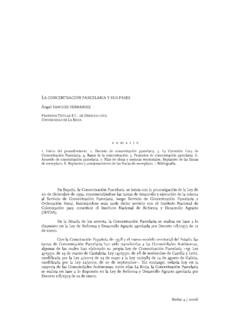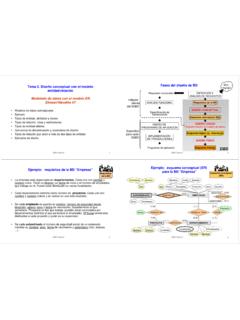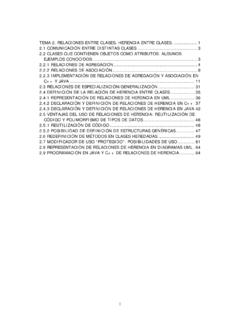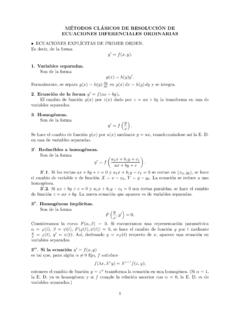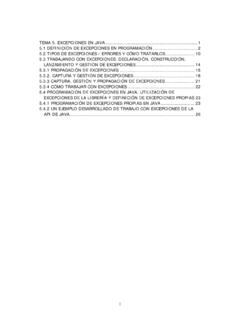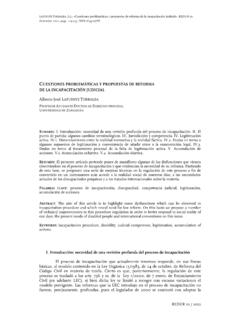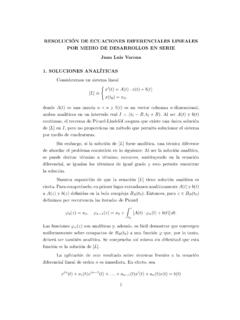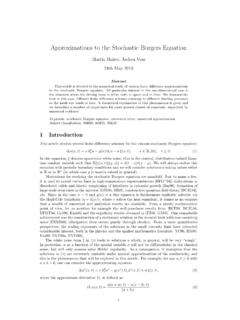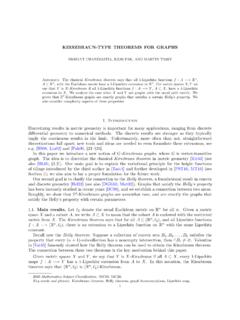Transcription of Gauss-Seidelization of iterative methods for solving ...
1 The Gauss-Seidelization of iterative methods for solvingnonlinear equations in the complex plane Jos e Manuel Guti errez, Angel Alberto Magre n an and Juan Luis Varona Dpto. de Matem aticas y Computaci on, Universidad de La Rioja, 26004 Logro no, to the memory of Professor Sergio PlazaAbstractIn this paper we introduce a process we have called Gauss-Seidelization for solving nonlinear equa-tions. We have used this name because the process is inspired by the well-known Gauss-Seidel methodto numerically solve a system of linear equations. Together with some convergence results, we presentseveral numerical experiments in order to emphasize how the Gauss-Seidelization process influences onthe dynamical behavior of an iterative method for solving nonlinear Subject Classification (2010):Primary 65H05; Secondary 28A78, :Nonlinear equations, iterative methods , Box-counting dimension, IntroductionLet us suppose that we want to solve the linear system{ax+by= ,cx+dy= ,(1)wherea,b,c,d, , are fixed real constants.}
2 Starting in a point (x0,y0) R2, the well-known Jacobi methodfor solving the linear system (1) is defined by the following iterative scheme: xn+1= byna,yn+1= cxnd.(2)Under appropriate hypothesis, this iterative method generates a sequence{(xn,yn)} n=0that converges to(x,y), the solution of (1).Let us suppose that{(xn,yn)} n=0is approaching the solution (x,y). To compute (xn+1,yn+1) in (2), wefirst computexn+1; heuristically speaking, we can thing thatxn+1is closer to the solution thanxn. So This paper has been published inApplied Math. (2011), 2467 2479. The research is partially supported by the grants MTM2008-01952 (first and second authors) and MTM2009-12740-C03-03(third author) of the DGI, idea is to usexn+1instead ofxnto evaluateyn+1in (2). The corresponding algorithm, xn+1= byna,yn+1= cxn+1d,(3)is the well-known Gauss-Seidel method for solving (1).
3 Notice that we can also define the following variant of the Gauss-Seidel method, just by changing theroles ofxandy: yn+1= cxnd,xn+1= byn+1a.(4)At a first glance, one can think that when both methods (2) and (3) converge to the solution (x,y),the Gauss-Seidel method converges faster than the Jacobi method. Of course, there are rigorous resultsdealing with the convergence of both Jacobi and Gauss-Seidel iterative methods to solve linear systems (andnot only inR2, but inRd). They can be found in many books devoted to numerical analysis. But the aimof this paper is not to study linear , we are going to consider a complex function :C Cand an iterative sequencezn+1= (zn), z0 C.(5)If we takeU= Re ,V= Im ,zn=xn+yniwe can write (5) as a system of recurrences{xn+1=U(xn,yn),yn+1=V(xn,yn), (x0,y0) R2.}
4 (6)Although (6) is, in general, a non-linear recurrence, we can consider the same ideas used to construct theGauss-Seidel iterative methods (3) or (4). In fact, we can define{xn+1=U(xn,yn),yn+1=V(xn+1,yn),(x0 ,y0) R2,(7)or{yn+1=V(xn,yn),xn+1=U(xn,yn+1),( x0,y0) R2.(8)We say that (7) (or (8)) are theGauss-Seidelization(or theyx- Gauss-Seidelization ) of an iterative method (5).In general, the theoretical study of the dynamics for (7) or (8) can be much more difficult than the study ofdynamics for (5), because complex analysis can no longer be used in the mathematical instance, let us consider the famous Mandelbrot set, defined as the set of pointsc Cfor which theorbit of 0 under iteration of the complex quadratic polynomialzn+1=z2n+cremains bounded. In [4] it isintroduced a variation of the Mandelbrot set, called as Chicho set, that is mainly a Gauss-Seidelization ofthe Mandelbrot set.}}
5 In fact, if we writec=a+bi(witha,b R) andzn=xn+iyn, the previous complexiterative sequence can be written as(xn+1,yn+1) =Mc(xn,yn),whereMc(x,y) = (x2 y2+a,2xy+b).The Gauss-Seidelization process applied to the functionMc(x,y) gives raise to the iteration of the functionTc(x,y) = (x2 y2+a,2(x2 y2+a)y+b).2 Figure 1: The Mandelbrot set and its Gauss-Seidelization , the Chicho this context, we obtain the Chicho set as the set of the parameterscsuch thatTnc(0,0) is bounded whenn .Some basic properties and a computer picture of the Chicho set are presented in [4]. Perhaps, it couldbe surprising to see that both sets, Mandelbrot and Chicho, have a completely different dynamical instance, it is well known (and easy to check) that if one of the steps of the sequencezn+1=z2n+chas a modulus greater than 2, then|zn|.
6 Consequently, the correspondingcdoes not belong to theMandelbrot set. But, as far as we know, there is not a similar result for the Chicho set, and thus it is verydifficult to build an algorithm to ensure thatc=a+biis not in the Chicho set. We can compare the aspectof Mandelbrot and Chicho sets in Figure kind of ideas can be also applied to define the Gauss-Seidelization of a Julia set on the complexplane. In particular, in this paper we are interested in studying the Gauss-Seidelization of some iterativemethods that are used for solving nonlinear equations on the complex in this paper we are mainly concerned in some dynamical aspects about the Gauss-Seideliza-tion process, there are other questions that eventually could be taked into account. For instance, as thecomputer time to calculate every step in (7) (or (8)) is equivalent to the time used for every step in (6),from a computational point of view, the Gauss-Seidelizations of a convergent iterative method could serve toincrease the speed of convergence.
7 In the same way, we can wonder ourselves about the influence of the Gauss-Seidelization process in other computational indexes such as the computational order of convergence [9] orthe efficiency index [6, 13].2 iterative methodsThe most famous iterative method for solving nonlinear equations is Newton s method (also known asNewton-Raphson s method). In the real line, if we have a differentiable functionf:R R, and we want tofind a solutionx Rwe can takex0 Rand find the tangent line to the curvey=f(x) on (x0,f(x0)).This tangent line intersects the real axis at a pointx1given byx1=x0 f(x0)/f (x0). Usually,x1is abetter approximation tox thanx0and, of course, we can iterate and calculatex2,x3, and so on. Underadequate conditions for the iteration functionfand the starting pointx0, the sequence{xn} n=0tends tothe rootx.
8 This iterative method has a natural generalization for finding the roots of complex functionsf:C fact, Newton s method to solve nonlinear equations in the complex plane is given byzn+1=zn f(zn)f (zn), z0 C.(9)If we havez such thatf(z ) = 0 and we start withz0close enough toz , the iterative method (9) willconverge toz whenn . In the literature there are many works that study this method, showing manydifferent kind of sufficient conditions that guarantee its convergence (see, for instance, [2, 13] or [15]).Given an iterative method and a rootz , theattraction basinofz is the set of all the starting pointsz0 Csuch that the iterative method converges toz . Every root has its own attraction basin and it is wellknown that, in general, the frontier between the attraction basins is not a simple line, but a intricate fractal,a Julia set whose Hausdorff dimension is greater than 1.
9 This happens, in particular, when the functionfisa polynomial of degree greater than 2 (see, for instance, [5] or [11, Section ], although there are hundredsof papers and books that could be cited).Clearly, (9) is a particular case of (5), so we can apply to this equation the Gauss-Seidelization processesseen in (7) or (8). To do that, let us denotez=x+yi(and the same with subindexes) andf(z) =u(x,y) +iv(x,y). Taking into account the Cauchy-Riemann equations, we can writef (z) =ux(x,y) +ivx(x,y) andthen (9) becomesxn+1+iyn+1=xn+iyn u(xn,yn) +iv(xn,yn)ux(xn,yn) +ivx(xn,yn).Now, after multiplying the numerator and the denominator byux(xn,yn) ivx(xn,yn), we separate the realand imaginary parts to obtain xn+1=xn u(xn,yn)ux(xn,yn) +v(xn,yn)vx(xn,yn)ux(xn,yn)2+vx(xn,yn)2, yn+1=yn v(xn,yn)ux(xn,yn) u(xn,yn)vx(xn,yn)ux(xn,yn)2+vx(xn,yn)2,t hat is equivalent to (9) and has the form (6).
10 In this way we can easily obtain the corresponding Gauss-Seidelization (7) (or theyx- Gauss-Seidelization (8)) for the Newton us illustrate these processes with a particular example. We apply Newton s method (9) to the functionf(z) =z3 1 to obtainzn+1=zn z3n , takingzn=xn+iynand separating into real and imaginary parts we have xn+1=xn x5n+ 2x3ny2n x2n+xny4n+y2n3(x2n+y2n)2,yn+1=yn x4nyn+ 2x2ny3n+ 2xnyn+y5n3(x2n+y2n) , the Gauss-Seidelization (7) of this process is xn+1=xn x5n+ 2x3ny2n x2n+xny4n+y2n3(x2n+y2n)2,yn+1=yn x4n+1yn+ 2x2n+1y3n+ 2xn+1yn+y5n3(x2n+1+y2n)2,and theyx- Gauss-Seidelization (8) is yn+1=yn x4nyn+ 2x2ny3n+ 2xnyn+y5n3(x2n+yn)2,xn+1=xn x5n+ 2x3ny2n+1 x2n+xny4n+1+y2n+13(x2n+y2n+1) happens with the attraction basins when we make the Gauss-Seidelization process? As we havemention above, the conditions for the convergence of an iterative method and its Gauss-Seidelizations aredifferent, and (at least for solving a linear system) often the Gauss-Seidelizations converge faster than theoriginal method.

![riesgos eléctricos.ppt [Modo de compatibilidad]](/cache/preview/7/5/c/3/2/c/4/7/thumb-75c32c47568599c6a4bc48da5323bd04.jpg)
